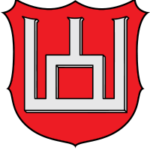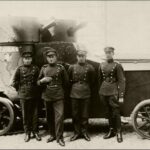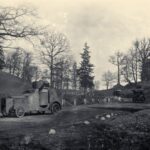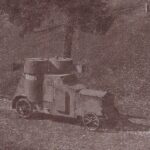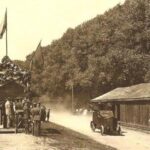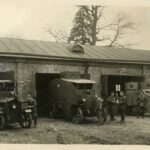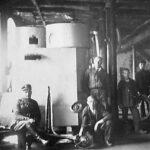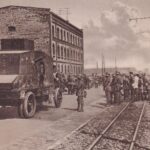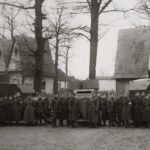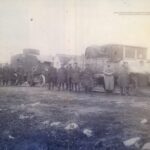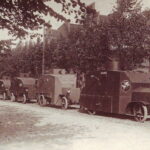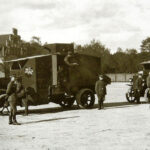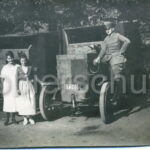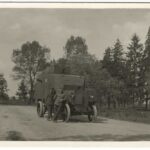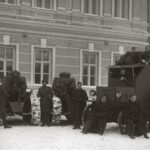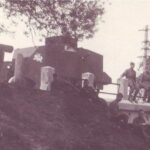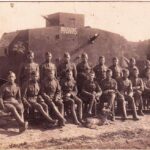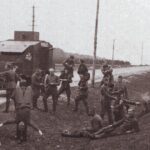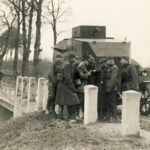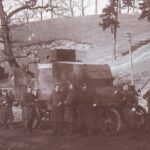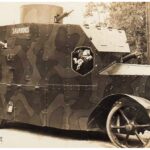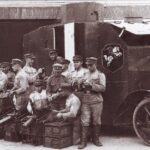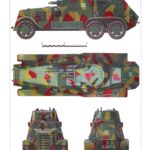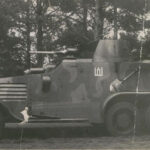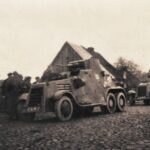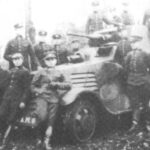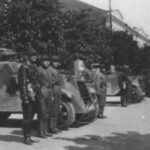The Columns of Gediminas:
The Columns of Gediminas or Pillars of Gediminids are one of the earliest symbols of Lithuania and one of its historical coats of arms. They were used in the Grand Duchy of Lithuania, initially as a rulers’ personal insignia, a state symbol, and later as a part of heraldic signs of leading aristocracy. During the period between World War I and World War II they were used by the Lithuanian Republic as a minor state symbol, e. g. on Litas coins and military equipment.
Armored cars:
On July 1, 1919, the available armored vehicles were integrated in the Armored Division of the Lithuanian Armed Forces, and on December, 1, they started operating in the newly formed Autobattalion. On March 1, 1920, the Autobattalion started functioning as a separate unit. At first, the elements of the Autobattalion were scattered almost all over Kaunas, the Headquarters were at St. Michael the Archangel Church, and the barracks at Gedimino st. 12. However, soon the Headquarters and office were established at Vytautas Ave. 65, the officers were accommodated at Donelaitis st. 12, and the soldiers – in the house of lawyer Rapolas Skipitis, Gedimino st. 36. In addition, there were no places for the armored vehicles, so they were kept outside. In August 1, 1921, the armored unit was renamed Armored Car Division. in January 18, 1922, the soldiers of this Division moved to the barracks in Žaliakalnis area, and on April 25 after the garages were installed, the armored vehicles moved to a new location in Vytautas mountain. In 1926-1927, the area of armored vehicles and the barracks in Žaliakalnis area were arranged and adapted for their deployment. The barracks, which were next to the barracks of the Hussar Regiment, were surrounded by a fence more than 2 m high. Part of the barracks rested on Ėuolynas. There were 3 brick buildings in the Sharvuotinkai district, and the garages could accommodate about 12 different vehicles. in January 1, 1924, the Armored Car Division, the armored Train Battalion and the Tank Battalion were assigned to the new formed Armored Corps, and the Armored Car Division was reformed into the Armored Car Company. On September 16, 1927, the Armored Corps was reformed again, it included the Headquarters, the Armored Car Company, the Armored Train Company and the Tank Company. in 1937 after another reform, the entire Armored Corps with Headquarters and units moved from Kaunas to Radviliškis.
The armored vehicles :
Zaibas:
Lithuania’s first armored car was according to sources either captured from the freikorps (maybe former Nurnberg, arguments are the metal wheels and machine guns) or captured from the Bolsheviks in 31 May 1919, and was an Izhorsky-Fiat armed with 2 MGs. The official story of its capture was as follow:
The objective of the Lithuanian forces was to capture the city of Utena. On May 31, the middle Lithuanian column moved at 9 a.m. along the highway to Leliūnai. The scooter riders were the first to go, followed by a machine gun company under the command of Bronius Bilminas. The column captured Diktarai and reached Lake Smulkis. Here the column encountered strong resistance – rifle and machine gun fire, as well as artillery shelling from Leliuni. In addition, an armored car « Fiat » was operating in the area.
The Reds counterattacked, occupied Dyktory, and the armored car moved along the highway about a kilometer west of Klivėnai. The Lithuanians (a group of soldiers and a junior commander), who had taken up positions behind a hill near Klivėnai, cut down several trees, blocking the return journey of the Red armored car. The stopped car was pelted with grenades. Shafer was wounded, the armored car was captured.
On April 16, 1920, the armored car was named « Žaibas » by the Lithuanians. « Zaibas » served in Memel (Klaipeda) when Hitler’s troops occupied this city in March of 1939, and was then captured.
Ehrhadt Behelfswagen:
In 1919, depending on sources, either the Allied Control Commission in Lithuania, turned over five German-built Erhardt Behelfswagen (meaning auxilliary armored vehicles) armored cars (formerly for Baltikum-Freikorps on the way to Riga) to the Lithuanian military, which it had seized from German forces, or on January 20, 1920, at the Virbalis railway station, Lithuanian troops themselves captured four german armored vehicles. After repairs, the vehicles were included in the only Lithuanian armored vehicle detachment, and received the following nicknames of: Nr. 4004″Aras », Nr. 3992″Perkunas », Nr. 4026″Pragaras », Nr. 4010″Sharunas ». One more has been taken as a prize from Bermont- Avalov’s troops, and named « Savanoris ». They were armed with 4 Maxim 7.92mm machine-guns. All except Aras, wore Vytis, the coat of arms of Lithuania and emblem of the first lituanian armored cars. They were used in combat against the Poles outside Vilnius in 1920. Although quite outclassed by the late 1930’s, these five armored cars served Lithuania well for over 20 years, until August/September of 1940. A Behelfswagen was a commercial 3 or 4 ton lorry from different brands (note that none were built by Daimler because none wore the Rietzl system) fitted with makeshift armour.
ARAS
Landsverk L-181:
In 1933 Lithuania ordered 6 L-181 armored cars from AB Landsverk in Landskrona, Sweden. These were delivered during 1934. They were marked with Landsverk numbers 29, 30, 31, 32, 33 and 34. They were built on Daimler-Benz chassis and were powered by a 6 cylinder 75hp engine with. They weighed 6.2 tons each, and had a maximum speed of 70 km/h. With a maximum range of 325km, their armor thickness varied from 5mm to 9mm. Armament consisted of a 20mm Oerlikon BW automatic-cannon and 2 x 7.92mm Maxim machine-guns. Ammo load was 300 x 20mm rounds, and 3,000 rounds for the machine-guns. It measured 5.56m in length, 2.00m in width and 2.45m in height. Crew was 4-5 men.
Their registrations plate in the lower front was marked with KAM 6-11. They were organized into an Armored Car Company, divided into 3 platoons with 2 L-181s in each, each for the 3 cavalry regiments and they were stationed in Radvilikis, Kaunas and Tauragé.

